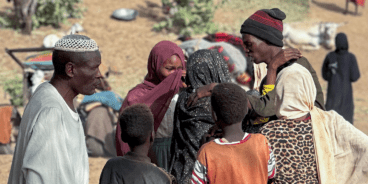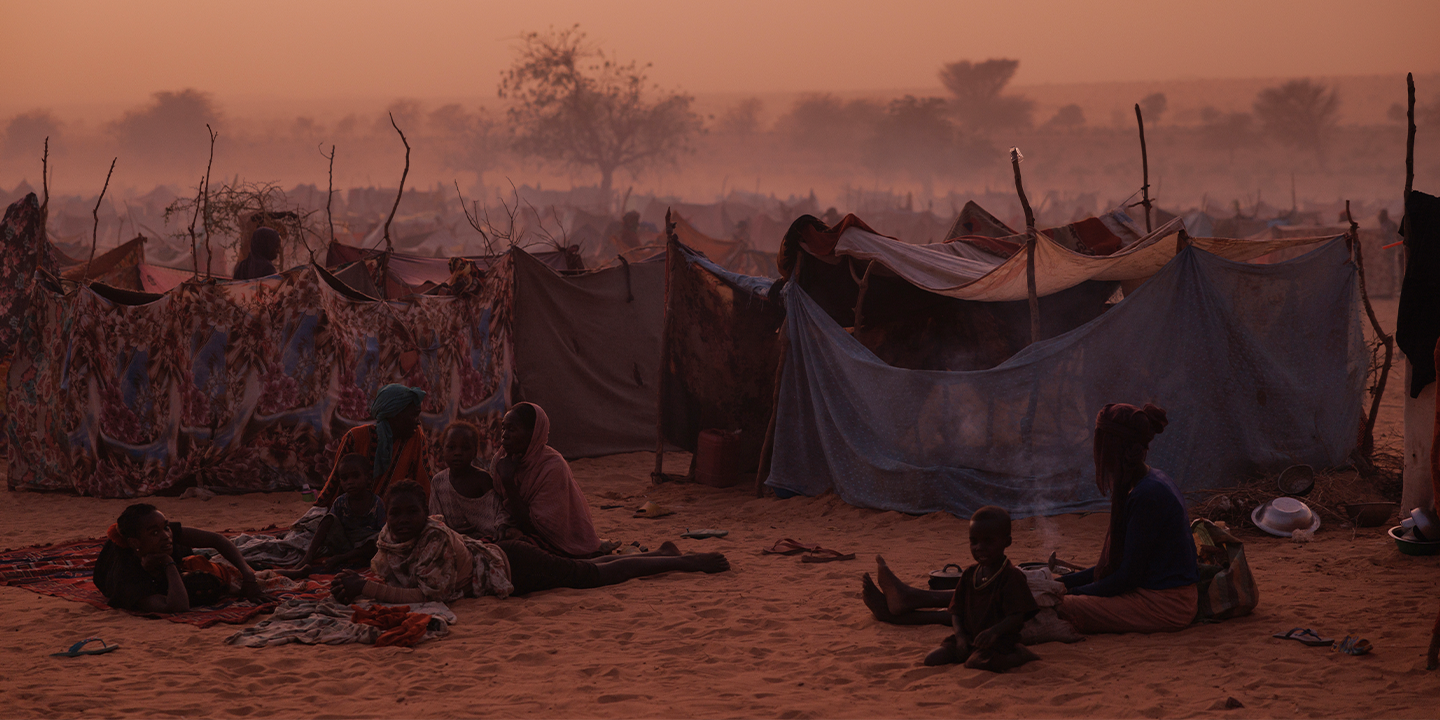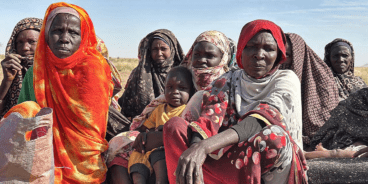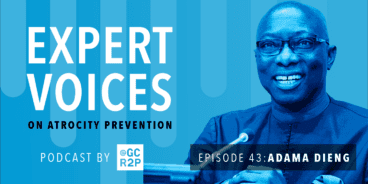

Twenty years of the Responsibility to Protect and the unfulfilled promise in Darfur
In 2005 all heads of state and government adopted the Responsibility to Protect (R2P) as a global political commitment to prevent genocide, war crimes, crimes against humanity and ethnic cleansing. This commitment emerged as a direct response to the international community’s failure to prevent and respond to atrocities in Rwanda and Srebrenica.
At the time R2P was being developed and debated, the 2003-2005 genocide in Darfur was actively exposing the devastating consequences of inaction once again. The crisis, marked by mass violence, sexual and gender-based violence and ethnically motivated killings amounting to genocide and other international crimes, highlighted the urgent need for a framework to ensure the world would never again stand idly by while vulnerable populations faced atrocities. It also emphasized the importance of investing in prevention to address risks before they escalated into mass violence, making Darfur a pivotal case in driving R2P forward. And yet, as we mark the 20th anniversary of R2P, the tragedy of Darfur reminds us how far we still must go. Two decades on, Darfur is once again the site of mass atrocities, as Sudan’s conflict enters its third year.
This raises crucial questions: What have we learned – or failed to learn – about atrocity prevention and response over the past two decades? Have the commitments under R2P translated into meaningful action, or are we witnessing the repetition of past failures? And when action is taken, what is needed to ensure that the tools available are sufficient to stop the trajectory of perpetrators determined to commit mass atrocities?
Progress and challenges in implementing R2P
Over the past two decades, R2P has made significant progress. It has shaped international responses to atrocity situations, equipped early warning mechanisms and reinforced the principle that sovereignty does not grant governments a license to kill their own populations. As a result of extensive efforts by governments, civil society organizations and atrocity prevention organizations and experts, including the Global Centre for the Responsibility to Protect, we now have a much deeper understanding of the risks, dynamics and contributing factors of these crimes, as well as the elements that can help mitigate or prevent their occurrence – along with a broad range of tools to respond more effectively.
However, R2P has also faced significant challenges, particularly when geopolitical interests take precedence or when domestic actors obstruct protection efforts to maintain power or evade accountability. The difficulty to mobilize collective action or to even condemn government actors responsible for atrocities in Syria, Myanmar, Gaza, Sudan and elsewhere reflects the gap between principle and practice. Despite broad recognition that prevention is more effective and far less costly – both in human lives and financial terms – the international community continues to underinvest in meaningful, sustained atrocity prevention.
That said, prevention in practice is undeniably politically contentious. It requires scrutiny of internal affairs, especially human rights practices and governance structures. Sovereignty is often invoked as a shield against external monitoring, limiting access to critical early warning information, obstructing diplomatic engagement and undermining efforts to address root causes, as these measures may expose patterns of discrimination, repression or structural inequalities. States hesitate to criticize other states over human rights practices or atrocity risks, wary of straining diplomatic ties, jeopardizing economic interests and upsetting geopolitical alliances. As a result, long-term prevention strategies – those with no immediate political return – are routinely sidelined both nationally and internationally. This failure to prioritize prevention is precisely why crises like Darfur persist and resurface: without a genuine commitment to prevention, atrocity crimes continue to devastate communities while the world reacts too late, if at all.
International response to atrocities in Darfur in 2003-2005
The genocide in Darfur, which claimed approximately 300,000 lives and displaced millions, was driven by a complex network of political and military actors, with the Sudanese government and its allied Arab Janjaweed militia at the center. Under President Omar al-Bashir, the government orchestrated a brutal campaign to crush the rebellion in Darfur, using the Janjaweed to carry out systematic violence, including mass killings, rape and widespread destruction targeting civilians – particularly from the Fur, Masalit and Zaghawa ethnic groups. These actions were part of a wider effort to maintain control over the region and silence opposition.
The scale of devastation in Darfur was impossible to ignore. As atrocities mounted, so did the calls for action. Civil society organizations were instrumental in raising the alarm: through relentless advocacy, documentation and public mobilization, they helped shine an international spotlight on the crisis. Among them, the Save Darfur Coalition – launched in 2004 – rallied millions and played a key role in generating unprecedented global attention to the atrocities in Darfur. These efforts helped spur action by governments and the international community, leading to key responses, such as the UN Security Council’s referral of the situation to the International Criminal Court (ICC), the imposition of an arms embargo and sanctions and the establishment of the UN–African Union Hybrid Mission. However, these actions came only after immense human suffering had already occurred – underscoring the high cost of delayed action.
Despite facing charges of war crimes and crimes against humanity, and later genocide, at the ICC, President Bashir managed to sustain his power for over a decade after the conflict. In 2013 Bashir integrated the Janjaweed into Sudan’s security forces, creating the Rapid Support Forces (RSF) under the command of Mohamed Hamdan Dagalo, known as “Hemedti.” The RSF quickly became a powerful paramilitary force, operating independently from Sudan’s regular army (SAF). Violence continued, impunity reigned and deep-rooted grievances remained unaddressed. The marginalization of certain ethnic communities not only persisted but undermined efforts to create the conditions necessary for lasting peace. International interventions, however expansive, well-intentioned and forceful, are only as effective as the domestic political will that supports them. In Darfur, that will was glaringly absent. Promising international measures were ultimately undercut by Sudanese leaders obstructing or manipulating peace and reform processes – allowing violence and instability to persist.
In light of these challenges, has the international community – including not just multilateral and regional bodies, but also neighboring states and other regional governments with leverage over Sudanese leaders – done enough to push for meaningful structural reforms and hold bad-faith political actors accountable? Or has it allowed destructive dynamics to persist, making sustainable peace ever more elusive and leaving the people of Darfur to continue paying the price?
The failure to uphold accountability and its impact on ongoing abuses in Darfur
As our understanding of R2P and atrocity prevention has developed, a key lesson stands out: addressing past crimes and holding perpetrators accountable is non-negotiable. This means not only criminal responsibility but also political accountability, ensuring that those who misuse power, violate human rights or commit atrocities face consequences and are marginalized in future political processes. Despite some international efforts to hold perpetrators of the atrocities in Darfur accountable, impunity prevailed, and those responsible remained in power. Under President Bashir’s authoritarian regime (1989-2019), the ethnic and regional inequalities that fueled the Darfur conflict remained unaddressed. Political participation was suppressed, democratic reforms were stifled and power remained concentrated in the hands of loyalists – perpetuating exclusionary governance that deepened divisions and fueled violence.
One such loyalist was Hemedti, who became a central figure in Sudan’s political and security landscape over the past two decades as a key commander of the Janjaweed in the early 2000s and, subsequently, the RSF. After Bashir’s ouster in April 2019, Hemedti positioned himself as a key powerbroker in Sudan’s political transition, negotiating with civilian leaders.
Yet, it is crucial to remember: the road to this political transition was not paved by international interventions, but instead by the courage and determination of the Sudanese people. In 2018, after decades of repression, inequality and violence, millions took to the streets in a historic revolution. Led by grassroots movements and Resistance Committees, this people-powered revolution culminated in the ousting of Bashir. It was a powerful, collective demand for political change, democracy, justice and an end to the cycle of violence. Above all, it demonstrated that lasting peace and meaningful change cannot be imposed from the outside – it must be owned by the Sudanese people.
In the period that followed, Sudan underwent multiple significant political changes. Leadership was initially handed to a joint civilian-military transitional Sovereign Council. Yet the presence of Hemedti as the Sovereign Council’s deputy chairman, despite accusations of involvement in the June 2019 Khartoum massacre where RSF forces killed over 100 pro-democracy protesters, solidified his influence in the post-Bashir power structure.
Throughout the transition, international actors treated Hemedti and the RSF as indispensable. Despite their known record of atrocities, including in Darfur, as well as his role in the October 2021 military coup, they were seen as essential for keeping the military aligned with the civilian leadership and ensuring some level of security amid ongoing unrest. This international support was controversial and sparked deep concern among Sudanese people and local grassroots organizations, who repeatedly raised alarm about Hemedti’s continued involvement in human rights abuses and atrocities, especially in Darfur. By engaging with such actors, the international community legitimized their authority and entrenched their power, undermining prospects for meaningful peace and stability.
As tensions escalated between Hemedti and General Abdel Fattah al-Burhan, commander of the SAF and Sudan’s de facto leader, Hemedti sought to consolidate power independently. These tensions erupted into open conflict in April 2023, derailing Sudan’s fragile transition and plunging the country into a full-scale war.
Amid this chaos, Hemedti has used the war to intensify a renewed campaign of ethnic cleansing and genocide in Darfur, with little international scrutiny or intervention. The RSF’s tactics follow a brutal and systematic pattern: surrounding towns, blocking access to essential resources like food, medicine, electricity and telecommunications and then unleashing waves of violence – arson, sexual violence, targeted killings and the deliberate destruction of critical infrastructure. Since the outbreak of conflict in 2023, Darfur has seen horrific atrocities, with thousands of civilians killed, hundreds of thousands displaced and a dramatic surge in sexual violence, particularly targeting women and girls. Hemedti’s objective appears terrifyingly clear: to consolidate power and complete the unfinished agenda of ethnically cleansing and exterminating Darfur’s non-Arab populations.
While reports of ethnically motivated killings, mass displacement and systematic violence have raised alarms of genocide in Darfur, the international community’s response has once again been slow, hampered by political deadlock, competing interests and external involvement. As before, those most at risk are left unprotected, while the cycle of violence continues.
R2P’s three pillars and the need for long-term atrocity prevention strategies
In the early months of the conflict in 2023, the international community struggled to grasp the complexity of the unfolding violence. Responses were largely shaped through a conflict prevention lens, with efforts focused on stopping the broader war between the SAF and RSF. But this narrow approach failed to account for the diverse and evolving nature of the violence. Sudan’s crisis involved not only the RSF and SAF but also numerous ethnic militias, each with its own motivations, grievances and methods of violence. The failure to recognize these varying trajectories of violence – each requiring a tailored response – left international actions often ineffective.
This gap in understanding had real consequences. The UN Security Council’s resolution in June 2024 – focusing on the escalating violence in El Fasher, North Darfur – came a year after early reports of ethnically motivated killings. A stronger focus on atrocity prevention from the outset might have led to swifter and more effective responses: the mobilization of international resources for civilian protection, early intervention to prevent ethnic targeting or stronger condemnation and sanctions against those responsible for the genocidal violence. Crucially, this would have required listening to Sudanese voices, who had long warned about the escalating risks and unresolved root causes of the conflict.
Two decades of advancing our understanding of atrocity prevention have shown that R2P’s three pillars – while distinct – must work in tandem. Effective prevention efforts under Pillar II can strengthen a state’s ability to uphold its Pillar I responsibilities, reducing the need for more coercive measures outlined in Pillar III. Conversely, decisive action under Pillar III may be necessary to restore stability, creating space for longer-term support and capacity-building efforts, but will only be effective if complemented by domestic processes to rebuild and strengthen the state’s ability to uphold its Pillar I responsibility. This interplay underscores that R2P’s effectiveness depends on the strategic and coordinated application of all three pillars.
As the international community works to end the violence and suffering in Darfur, it must avoid falling into the familiar trap of short-term crisis management. It is essential to prioritize long-term atrocity prevention strategies that address root causes and build local resilience. This demands proactive engagement with a wide range of actors, including civil society, regional organizations and local communities, to build resilience against future atrocities. Ironically, those who once led the historic political revolution toward peace, democracy and justice are now being sidelined – while the actors responsible for past and ongoing atrocities are engaging with the international community, presenting roadmaps, drafting national protection plans and establishing parallel governments as they seek support and legitimacy on the global stage.
Although coercive measures were not lacking in response to the Darfur genocide two decades ago, the failure to ensure accountability – both criminal and political – has directly contributed to today’s crisis. And yet, the international community continues to engage with those same actors, who remain implicated in large-scale human rights violations that may amount to war crimes, crimes against humanity or genocide. This raises serious doubts about their willingness or ability to pursue genuine peace, protect civilians or uphold responsibilities under international law.
Given the history of failed commitments and ongoing violations, the international community’s response to both the SAF and RSF must be cautious and conditional. Any engagement should be tied to strict benchmarks focused on accountability and verifiable progress in civilian protection and addressing root causes. Parties to the conflict should not be allowed to use diplomatic maneuvers to distract from their actions on the ground. The international community must prioritize civilian protection and human rights monitoring, while pressuring all parties to the conflict to ensure a peace process that is inclusive and results in tangible change, rather than simply serving as a platform for reasserting control.
This also means recognizing that Sudanese civil society and grassroots movements are not just peripheral voices in the peace process – they are essential partners in shaping and implementing the solution. It was their mobilization that sparked historic political change. Their continued exclusion from formal processes undermines the prospects for sustainable peace. A durable solution cannot emerge from deals struck solely between military leaders and armed groups – it must be created by the Sudanese people themselves. The international community must stop prioritizing short-term stability at the expense of long-term, inclusive peace.
Over the past 20 years, it has become painfully clear that the challenge is not a lack of frameworks, but the repeated failure to use them effectively. To truly protect populations from atrocity crimes, the R2P framework must be underpinned by political courage and a genuine commitment to act in real-time. The ongoing crisis in Darfur is not only a challenge to R2P; it is a critical test of the international community’s resolve to protect civilians, even when doing so requires reassessing its engagement with those in power and taking difficult steps toward accountability.
Meeting this moment means fundamentally rethinking how we approach conflict and atrocity prevention. It requires listening to and working with actors outside existing power structures, empowering Sudanese communities and supporting alternative models of leadership and governance that place human rights and the protection of vulnerable populations at their core. If the international community is serious about ending the cycle of violence in Sudan, it must stop prioritizing what is politically convenient and start acting on what is morally imperative.
Related Content


Joint Statement: Genocide Returns to Darfur
